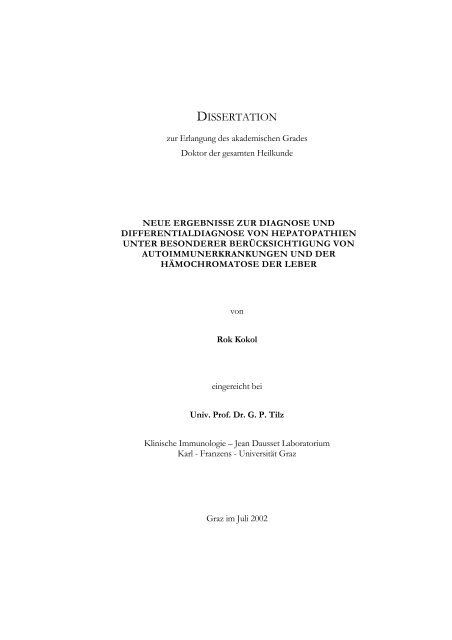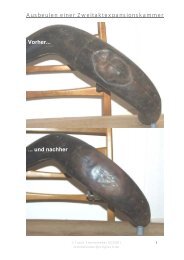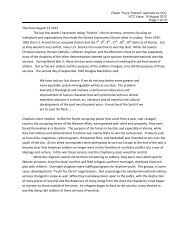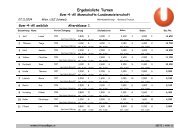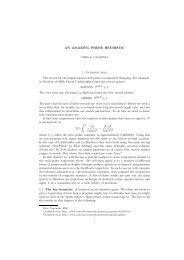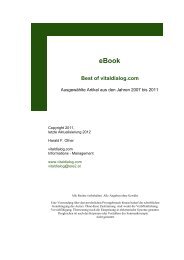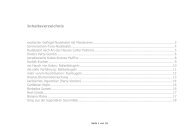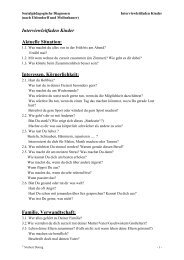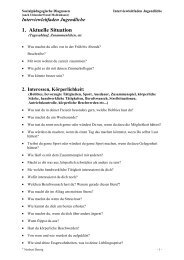DISSERTATION - Tele2
DISSERTATION - Tele2
DISSERTATION - Tele2
Erfolgreiche ePaper selbst erstellen
Machen Sie aus Ihren PDF Publikationen ein blätterbares Flipbook mit unserer einzigartigen Google optimierten e-Paper Software.
<strong>DISSERTATION</strong><br />
zur Erlangung des akademischen Grades<br />
Doktor der gesamten Heilkunde<br />
NEUE ERGEBNISSE ZUR DIAGNOSE UND<br />
DIFFERENTIALDIAGNOSE VON HEPATOPATHIEN<br />
UNTER BESONDERER BERÜCKSICHTIGUNG VON<br />
AUTOIMMUNERKRANKUNGEN UND DER<br />
HÄMOCHROMATOSE DER LEBER<br />
von<br />
Rok Kokol<br />
eingereicht bei<br />
Univ. Prof. Dr. G. P. Tilz<br />
Klinische Immunologie – Jean Dausset Laboratorium<br />
Karl - Franzens - Universität Graz<br />
Graz im Juli 2002
ROK KOKOL – <strong>DISSERTATION</strong><br />
NEW RESULTS ON DIAGNOSIS AND DIFFERENTIALDIAGNOSIS<br />
OF LIVER DISEASES UNDER SPECIAL CONSIDERATION OF AUTOIMMUNDISEASES AND THE<br />
HEMOCHROMATOSIS OF THE LIVER<br />
ABSTRACT<br />
Mutations in the HFE gene are widespread in the general population. In spite of this<br />
fact, the disease is rarely correctly diagnosed. H63D and S65C mutations hardly ever<br />
lead to a typical clinical case of hemochromatosis. These mutations are often<br />
responsible for abnormal blood values and are difficult to classify, therefore leading to a<br />
wrong diagnosis. For example, patients with elevated transaminase or bilirubin values<br />
might be misdiagnosed as suffering from alcoholism.<br />
74 patients were examined for HFE mutations at the institute of Clinical Immunology<br />
in Graz. Of these, one was homozygote and five were heterozygote for the C282Y<br />
mutation, 17 were heterozygote for the H63D mutation, one was heterozygote for the<br />
S65C mutation and one was heterozygote for the C282Y and H63D mutations.<br />
The higher glucose values of patients with a heterozygote mutation in the HFE gene<br />
were especially noticeable. Diabetes mellitus is a common disease, often related to<br />
overweight and inheritance. Although various other genetic defects play a role in the<br />
inheritance of diabetes mellitus, HFE mutations also often play a role. All of the C282Y<br />
heterozygotes had increased glucose values; this represented 76,92% more cases than in<br />
the control group. 7 of the 17 H63D heterozygotes also had increased glucose values.<br />
That was almost twice as much as in the control group. No conclusions could be draw<br />
concerning the other patients with HFE mutations due to the low patient count.<br />
The statistics for GOT, GPT, γ-GT and other liver values show that patients with HFE<br />
mutations tend to have increases in these values. These patients could be misdiagnosed<br />
if the HFE mutations are not recognised. Acute liver damage resulting from alcohol<br />
abuse might be diagnosed if these elements are not taken into consideration.<br />
II
Der Autor bedankt sich bei:<br />
DANKSAGUNGEN/WIDMUNGEN<br />
Univ. Prof. Dr. G. P. Tilz für die Unterstützung und Betreuung während des Studiums und Hilfe<br />
bei der Dissertation. Vor allem aber möchte ich mich bedanken in ihm ein Vorbild sowohl auf<br />
beruflicher als auch auf menschlicher Ebene gefunden zu haben.<br />
Univ. Prof. Dr. Gilbert Reibnegger für die Unterstützung bei der Dissertation und Motivation am<br />
Anfang des Studiums.<br />
Meiner Verlobten Dr. Michaela Pötscher für die Korrekturen, Unterstützung und Motivation bei<br />
der Arbeit.<br />
Meiner Mutter DI Domina Kokol für die Hilfe bei den englischen Tabellen, Texten, Motivation<br />
und Unterstützung.<br />
Meinem Vater DI Marjan Kokol für die Hilfe beim Layout und Drucken von Farbbildern,<br />
Tabellen, Korrekturen und Unterstützung.<br />
Zum Gedenken an meinen Großvater Jože Kokol, der durch den Ausbruch des Zweiten<br />
Weltkrieges sein Medizinstudium an der Universität Graz abbrechen musste.<br />
III
INHALTSVERZEICHNIS<br />
Kapitel 1<br />
LEBERERKRANKUNGEN – GRUNDLAGEN.......................................................................................................1<br />
INFEKTIONSKRANKHEITEN ..........................................................................................................................................1<br />
AUTOIMMUNERKRANKUNGEN ....................................................................................................................................2<br />
AUTOIMMUNHEPATITIS (AIH) ....................................................................................................................................3<br />
Diagnose der AIH ..................................................................................................................................................4<br />
Klinisches Bild der AIH .........................................................................................................................................4<br />
Laborbefunde bei AIH ...........................................................................................................................................5<br />
Leberhistologie bei AIH.........................................................................................................................................5<br />
Therapie und Prognose der AIH ...........................................................................................................................5<br />
Sonderformen der AIH...........................................................................................................................................7<br />
PRIMÄR BILIÄRE ZIRRHOSE (PBC)..............................................................................................................................7<br />
Diagnose der PBC .................................................................................................................................................8<br />
Therapie und Prognose der PBC ..........................................................................................................................9<br />
PRIMÄR SKLEROSIERENDE CHOLANGITIS (PSC).......................................................................................................10<br />
Epidemiologie der PSC........................................................................................................................................10<br />
Diagnose der PSC................................................................................................................................................10<br />
Therapie und Prognose der PSC.........................................................................................................................10<br />
ERBLICHE KRANKHEITEN..........................................................................................................................................11<br />
TUMORE.....................................................................................................................................................................11<br />
VERGIFTUNGEN .........................................................................................................................................................12<br />
FETTLEBER ................................................................................................................................................................12<br />
LEBERZIRRHOSE ........................................................................................................................................................12<br />
"GELBSUCHT"............................................................................................................................................................14<br />
ANDERE ERKRANKUNGEN.........................................................................................................................................14<br />
Kapitel 2<br />
HÄMOCHROMATOSE UND EISENSTOFFWECHSEL ...................................................................................15<br />
ZUSAMMENFASSUNG.................................................................................................................................................15<br />
GESCHICHTE ..............................................................................................................................................................15<br />
ALLGEMEINES............................................................................................................................................................17<br />
Differentialdiagnose der erhöhten Eisenwerte im Serum...................................................................................17<br />
URSACHEN.................................................................................................................................................................18<br />
PCR - Testsystem für HFE - Mutationen (C282Y, H63D und S65C).................................................................20<br />
ANDERE URSACHEN EINER EISENÜBERLADUNG.......................................................................................................22<br />
Porphyria cutanea tarda......................................................................................................................................22<br />
Afrikanische Eisenüberladung.............................................................................................................................22<br />
Neonatale Hämochromatose ...............................................................................................................................22<br />
Juvenile Hämochromatose ..................................................................................................................................23<br />
Hereditäres Hyperferritinämie - Katarakt Syndrom...........................................................................................23<br />
Friedreich Ataxie .................................................................................................................................................23<br />
Hereditäre Atransferrinämie/Hypotransferrinämie............................................................................................24<br />
Hereditärer Caeruloplasmin - Mangel................................................................................................................24<br />
Sekundäre Eisenüberladung................................................................................................................................24<br />
HÄUFIGKEIT...............................................................................................................................................................25<br />
SYMPTOME ................................................................................................................................................................26<br />
Diabetes mellitus..................................................................................................................................................28<br />
Hautverfärbungen................................................................................................................................................28<br />
Gelenksbeschwerden............................................................................................................................................29<br />
Leberzirrhose und Leberkarzinom ......................................................................................................................29<br />
IV
Herzbeschwerden.................................................................................................................................................29<br />
Endokrine Probleme ............................................................................................................................................30<br />
EISENSTOFFWECHSEL ................................................................................................................................................30<br />
Eisengehalt und relative Bioverfügbarkeit von verschiedenen Nahrungsmitteln ..............................................32<br />
Menstruierende und schwangere Frauen............................................................................................................33<br />
Empfohlene Nahrungs - Eisen - Zufuhr...............................................................................................................34<br />
Oxidativer Stress und Eisenhomöostase..............................................................................................................34<br />
Eisenregulation ....................................................................................................................................................35<br />
DIAGNOSE..................................................................................................................................................................36<br />
Indirekte diagnostische Parameter......................................................................................................................36<br />
Direkte diagnostische Parameter ........................................................................................................................37<br />
Nichtinvasive Messung der Gewebseisenüberladung.........................................................................................38<br />
Typische diagnostische Parameter bei hereditärer Hämochromatose ..............................................................40<br />
Ferritin im Serum.................................................................................................................................................41<br />
Transferrinsättigung ............................................................................................................................................41<br />
Leberbiopsie.........................................................................................................................................................41<br />
Genetischer Hämochromatose - Test ..................................................................................................................42<br />
Ungesättigte Eisenbindungskapazität .................................................................................................................44<br />
Familiäre Studien der Hämochromatose ............................................................................................................44<br />
THERAPIE...................................................................................................................................................................44<br />
POPULATIONSSCREENING FÜR HÄMOCHROMATOSE.................................................................................................46<br />
KOMPLIKATIONEN.....................................................................................................................................................47<br />
PROPHYLAXE.............................................................................................................................................................47<br />
PROGNOSE .................................................................................................................................................................47<br />
Kapitel 3<br />
EIGENE DATEN VON PATIENTEN MIT C282Y -, H63D - UND S56C - MUTATIONEN ..........................48<br />
HINTERGRUND...........................................................................................................................................................48<br />
AUSGANGSWERTE .....................................................................................................................................................48<br />
GOT (GLUTAMAT – OXALAZETAT – TRANSAMINASE) ............................................................................................49<br />
DeRitis – Quotient................................................................................................................................................49<br />
GPT (GLUTAMAT – PYRUVAT – TRANSAMINASE)....................................................................................................50<br />
γ-GT (GAMMA – GLUTAMYLTRANSPEPTIDASE).......................................................................................................51<br />
GLUKOSE IM BLUT (I. S.)...........................................................................................................................................53<br />
Glukosetoleranz – Test.........................................................................................................................................53<br />
GESAMTBILIRUBIN.....................................................................................................................................................55<br />
EISEN .........................................................................................................................................................................56<br />
TRANSFERRIN ............................................................................................................................................................57<br />
CK (KREATINKINASE)...............................................................................................................................................58<br />
CHOLINESTERASE (CHE) ..........................................................................................................................................59<br />
EIWEIß........................................................................................................................................................................60<br />
EIWEIßELEKTROPHORESE ..........................................................................................................................................61<br />
HÄMOGLOBIN ............................................................................................................................................................62<br />
ERYTHROZYTENINDIZES............................................................................................................................................63<br />
LAKTAT – DEHYDROGENASE (LDH) ........................................................................................................................64<br />
DISKUSSION UND INTERPRETATION ..........................................................................................................................66<br />
V


